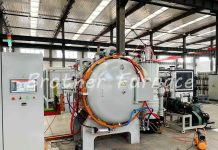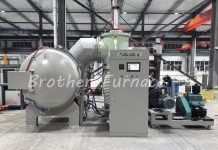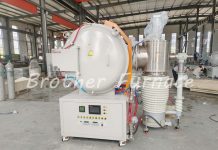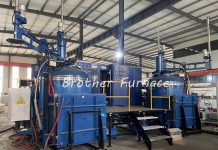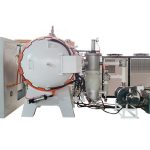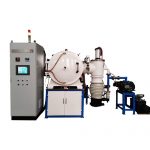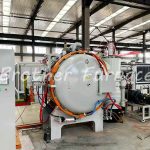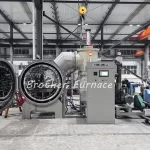Silicon nitride ceramics is a kind of inorganic material ceramics that does not shrink when sintered. It has properties such as high strength, low density, and high-temperature resistance. It was first produced by the direct reaction of monomeric silicon (Si) with nitrogen (N2) or ammonia (NH3) and was used as a bonding agent for silicon carbide (SiC) refractories.
The first silicon nitride ceramics were produced in 1955 by nitriding Si powder blanks. With the discovery of excellent mechanical properties, thermal properties, chemical stability and biocompatibility of silicon nitride ceramics, and the further development of powder preparation technology, sintering equipment, and technology, silicon nitride ceramics are gradually being used in machining, automotive, aerospace, electronic circuits, and wear.
Si3N4 ceramics are covalently bonded compounds with [ SiN4 ]4-tetrahedra as the structural unit. The silicon atom is located at the center of the tetrahedra, and the four vertex positions of the tetrahedra are occupied by nitrogen atoms, which are then repeatedly extended in three-dimensional space in the form of one atom shared by every three tetrahedra, eventually forming a network structure.
Sintering Silicon Nitride Ceramics
Preparation of silicon nitride powder
I Solid-phase reaction method
(1) Silicon powder direct nitriding method.
Raw material: silicon powder of high purity and nitrogen or ammonia gas
Chemical equation: 3Si + 2N2 → Si3N4
3Si+4NH3→Si3N4+6H2
Key points of the process: silicon powder impurities such as Fe, O, Ca < 2%, heating temperature ≤ 1400 ℃, need to pay attention to the particle size of silicon powder and the purity of N2; 1200 ~ 1300 ℃ α-Si3N4 content is high, but the product is coarse, need to be post-processing, easy to mix with impurities
(2) Carbon thermal reduction of silica method of self-propagation (SHS)
Method 1.
Raw material: silicon dioxide, carbon powder, and nitrogen
Chemical equation: 3SiO2 + 6C + 2N2 → Si3N4 + 6CO
Process points: process operation is simple, α-Si3N4 content is relatively high, and the particles are relatively fine
Method 2.
Raw material: silicon powder and nitrogen
Chemical equation: 3Si+2N2→Si3N4
Key points of the process: high purity of the product, energy saving, short synthesis reaction time, high sintering activity of the product
II liquid-phase reaction method (thermal decomposition method)
Raw material: silicon chloride, ammonia, hexane
Chemical equation: SiCl4+6NH3→Si(NH)2+ 4NH4Cl
3Si(NH)2→Si3N4+2NH3
3Si(NH2)4→Si3N4+8NH3
The main point of the process: this method has a fast reaction speed and can obtain silicon nitride powder in a relatively short period of time
Three gas phase reaction method (high temperature gas phase reaction method (CVD))
Raw material: SiCl4 or SiH4 and NH3
Chemical equation: 3SiH4+4NH3→Si3N4+12H2
Process point: limited to laboratory scale research, Si3N4 powder is high purity and ultra-fine, but the alpha phase content is very little and the productivity is very low
Preparation of silicon nitride ceramics
1. Reaction sintering method (RS)
Using the general molding method, the silicon powder or a mixture of silicon powder and silicon nitride powder is first pressed into a raw billet of the desired shape and pre-nitrided in a nitriding furnace at 1200°C. The pre-nitrided raw billet already has a certain strength and can be machined. Finally, the product is sintered again at 1400°C (the temperature of silicon melting point) or higher to obtain a product with little dimensional change. At this point, the product can be used without grinding.
Pros: low shrinkage, suitable for the preparation of complex shapes, precise size parts, low cost
Cons: long nitriding time, low strength, high porosity
2. Hot press sintering (HPS)
Si3N4 powder and sintering additives (such as MgO, Al2O3, MgF2, CeO2, Fe2O3, etc.) are sintered at a pressure of 1916 MPa or more and a temperature of 1600 °C or more. In the hot pressing sintering process, heating while pressurizing from the uniaxial direction makes the forming and sintering completed simultaneously, which can accelerate the rearrangement and densification of the material. If the Si3N4 ceramic material is pre-oxidized under the high-temperature condition of 1400~1500℃, the Si2N2O phase can be formed on the surface of ceramic material, it can significantly improve the oxidation resistance and high-temperature strength of Si3N4 ceramic.
Pros: the prepared Si3N4 ceramics have superior mechanical properties than Si3N4 sintered by other processes, high density, high strength, and short preparation cycle
Cons: high manufacturing cost, complex sintering equipment, high sintering shrinkage, single product shape
3. atmospheric pressure sintering (PLS)
In terms of increasing the pressure of sintering nitrogen atmosphere, the nature of Si3N4 decomposition temperature increase is used to perform atmospheric pressure sintering in the temperature range of 1700~1800℃, followed by pneumatic pressure sintering in the temperature range of 1800~2000℃. The use of pneumatic pressure promotes the densification of Si3N4 ceramics and thus increases the strength of the ceramics.
Pros: high density, high strength
Cons: high cost, complicated sintering equipment
4. Pneumatic sintering method (GPS)
Sintering of silicon nitride is performed at a temperature of about 2000°C under 1 to 10 MPa air pressure. The high nitrogen pressure inhibits the high-temperature decomposition of silicon nitride. The sintering temperature of this method is slightly higher than that of other sintering methods, and it can promote the growth of Si3N4 grains with the addition of fewer sintering aids, and the final sample is a long columnar grain ceramic with high density and strength.
Pros: high densities, high strengths, good wear resistance, complex shapes, and suitable for mass production
Cons: process conditions are relatively difficult to control
5. Discharge plasma sintering method
The discharge plasma sintering method has a fast heating rate, high sintering temperature, and uniform heating, which can achieve rapid sintering of dense sintered bodies.
Pros: simple operation, low technical requirements, fast sintering speed
Cons: large investment in equipment, single furnace output is small
6. Microwave sintering method
The most important feature of the microwave sintering method is its unique heating mechanism. Microwaves direct interaction with material particles (molecules, ions), the use of microwave has a special wavelength and the basic microstructure of the material coupled to generate heat, the material loss of the medium so that the overall heating of the material to the sintering temperature and achieve densification method. Because of its extremely fast heating rate, it is conducive to increasing the rate of densification, and can effectively inhibit the growth of grains, but also to obtain ceramic products that can not be obtained by conventional sintering methods.
Pros: the fast heating rate, high efficiency
Cons: expensive
Follow us on Facebook






